Oldman Formation
The Oldman Formation is a stratigraphic unit of Late Cretaceous (Campanian stage) age that underlies much of southern Alberta, Canada. It consists primarily of sandstones that were deposited in fluvial channel and floodplain environments. It was named for exposures along the Oldman River between its confluence with the St. Mary River and the city of Lethbridge, and it is known primarily for its dinosaur remains and other fossils.[3]
| Oldman Formation Stratigraphic range: Campanian, 77.5–76.5 Ma | |
|---|---|
| Type | Geological formation |
| Unit of | Belly River Group |
| Underlies | Dinosaur Park Formation |
| Overlies | Foremost Formation |
| Thickness | up to 328 feet (100 m)[1] |
| Lithology | |
| Primary | Sandstone |
| Other | Mudstone and bentonite |
| Location | |
| Coordinates | 49°37′41″N 112°53′23″W |
| Region | Western Canada Sedimentary Basin |
| Country | |
| Type section | |
| Named for | Oldman River |
| Named by | Russell, L.S. and Landes, R.W. |
| Year defined | 1940[2] |
 Oldman Formation (Canada) 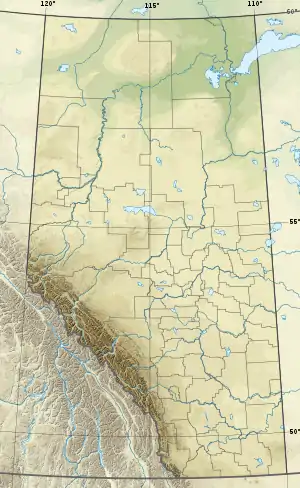 Oldman Formation (Alberta) | |
Lithology
The Oldman Formation is composed primarily of light-colored, fine-grained sandstones. They are upward-fining, lenticular to sheet-like bodies that are yellowish, steep-faced and blocky in outcrop. The formation also includes lesser amounts of siltstone and mudstone.[4]
Depositional environments
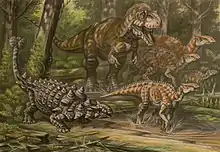
The sediments of the Oldman Formation were deposited in fluvial channels (the sandstones) and a variety of channel margin, overbank and floodplain environments (the siltstones and mudstones). The formation is about 40 metres (130 ft) thick at Dinosaur Provincial Park in southeastern Alberta. It thickens toward the southwest, and northwestern Montana appears to have been the primary source of the sediments.[4]
Relationship to other units
The Oldman Formation is a member of the Belly River Group (also known as the Judith River Group). It conformably overlies the Foremost Formation, and is separated from the overlying Dinosaur Park Formation by a regional disconformity. The sediments of the Oldman are superficially similar to those of the Dinosaur Park, which was included in the Oldman Formation prior to the recognition of the disconformity. The two formations can also be distinguished by petrographic and sedimentologic differences.[3][4]
Age
The Oldman Formation was deposited during the middle Campanian, between about 77.5 and 76.5 million years ago.[5] It lies fully within magnetic polarity Chron 33n.[6]
Fossil content
List of dinosaurs found in the formation:[5][7]
Color key
|
Notes Uncertain or tentative taxa are in small text; |
Theropods
| Theropods of the Oldman Formation | ||||||
|---|---|---|---|---|---|---|
| Genus | Species | Location | Stratigraphic position | Material | Notes | Images |
| Daspletosaurus | D. torosus | Lower | Several specimens | A tyrannosaurid |  | |
| Unnamed species[8] | Upper | A skull | A new species of tyrannosaurid | |||
| Dromaeosaurus | Indeterminate | Teeth | A dromaeosaurid | 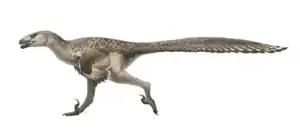 | ||
| Hesperonychus | H. elizabethae | Foot claw | A dromaeosaurid |  | ||
| Paronychodon | Indeterminate | Teeth | A troodontid | |||
| Prismatoolithus[9] | P. levis | Partial clutch containing 12 eggs | ||||
| Ricardoestesia | R. isosceles | Misreported | ||||
| Indeterminate | Teeth | A dromaeosaurid | ||||
| Saurornitholestes | S. langstoni | Partial remains | A dromaeosaurid | 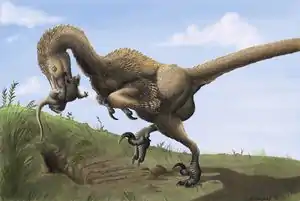 | ||
| Troodon | Dubious | Teeth, eggs, embryos | A dubious taxon of troodontid, most specimens formerly considered Troodon have been reassigned to other genera such as Stenonychosaurus | 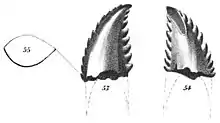 | ||
| Struthiomimus | S. altus | Several specimens, including a nearly complete skeleton[10] | An ornithomimid | 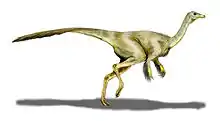 | ||
Ornithischians
| Ornithischians of the Oldman Formation | ||||||
|---|---|---|---|---|---|---|
| Genus | Species | Location | Stratigraphic position | Material | Notes | Images |
| Albertaceratops | A. nesmoi | Lower | A ceratopsid | 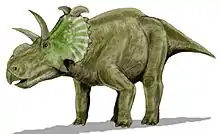 | ||
| Albertadromeus[11] | A. syntarsus | Upper | A thescelosaurid | |||
| Anchiceratops | Indeterminate | A ceratopsid | 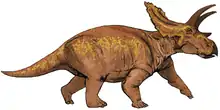 | |||
| Brachylophosaurus | B. canadensis | Upper | A hadrosaurid | 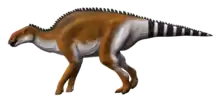 | ||
| Chasmosaurus | C. brevirostris | Junior synonym of C. russelli | 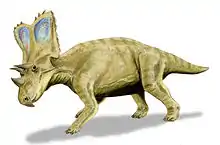 | |||
| C. russelli | Upper | A ceratopsid, also found in the Dinosaur Park Formation | ||||
| Coronosaurus | C. brinkmani | Upper | A ceratopsid | 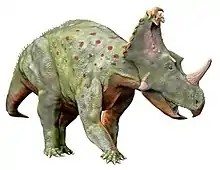 | ||
| Corythosaurus | C. casuarius | Upper | A hadrosaurid, also found in the Dinosaur Park Formation | |||
| Parasaurolophus | P. walkerii | Upper | A hadrosaurid, also found in the Dinosaur Park Formation | 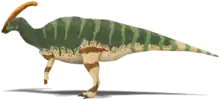 | ||
| Maiasaura | M. peeblesorum | Upper | A hadrosaurid, also known from the Two Medicine Formation.[12] | |||
| Foraminacephale | F. brevis | Also known from the Dinosaur Park Formation[13] | A pachycephalosaurid, once thought to be a species of Stegoceras |  | ||
| Hanssuesia | H. sternbergi | Upper, also present in the Dinosaur Park Formation and Judith River Formation | A pachycephalosaurid, once thought to be a species of Stegoceras | 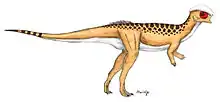 | ||
| Scolosaurus | S. cutleri | Upper | An ankylosaurid, may actually be from the Dinosaur Park Formation | 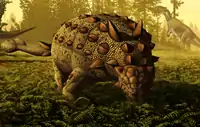 | ||
| Wendiceratops | W. pinhornensis | Lower | A centrosaurine described in 2015 | 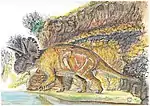 | ||
See also
- List of fossil sites (with link directory)
- List of dinosaur-bearing rock formations
References
- Lexicon of Canadian Geological Units. "Oldman Formation". Archived from the original on 2013-02-22. Retrieved 2009-02-06.
- Russell, L.S. and Landes, R.W., 1940. Geology of the southern Alberta Plains; Geological Survey of Canada, Memoir 221.
- Eberth, D.A. and Hamblin A.P. 1993. Tectonic, stratigraphic, and sedimentologic significance of a regional discontinuity in the upper Judith River Group (Belly River wedge) of southern Alberta, Saskatchewan, and northern Montana. Canadian Journal of Earth Sciences 30: 174-200.
- Eberth, D.A. 2005. The geology. In: Currie, P.J., and Koppelhus, E.B. (eds), Dinosaur Provincial Park: A Spectacular Ancient Ecosystem Revealed. Indiana University Press: Bloomington and Indianapolis, p. 54-82. ISBN 0-253-34595-2.
- Arbour, V.M.; Burns, M. E.; Sissons, R. L. (2009). "A redescription of the ankylosaurid dinosaur Dyoplosaurus acutosquameus Parks, 1924 (Ornithischia: Ankylosauria) and a revision of the genus". Journal of Vertebrate Paleontology. 29 (4): 1117–1135. doi:10.1671/039.029.0405.
- Lerbekmo, J.F. 1989. The position of the 33-33r (Campanian) polarity chron boundary in southeastern Alberta. Bulletin of Canadian Petroleum Geology 37: 43-47.
- Weishampel, D.B., Barrett, P.M., Coria, R.A., Le Loueff, J., Xu X., Zhao X., Sahni, A., Gomani, E.M.P., & Noto, C.N. 2004. Dinosaur distribution. In: Weishampel, D.B., Dodson, P., & Osmólska, H. (Eds.). The Dinosauria (2nd Edition). Berkeley: University of California Press. Pp. 517-606.
- Miyashita, Tetsuto; Currie, Philip; Paulina-Carabajal, Ariana (2013). "A new species of Daspletosaurus (Theropoda: Tyrannosauridae) from the Campanian of southern Alberta represented by a growth series of well-preserved skulls and skeletons". Journal of Vertebrate Paleontology. 33 (Supplement 1): 178.
- Zelenitsky, Darla K.; Hills, L.V. (1996). "An egg clutch of Prismatoolithus levis oosp. nov. from the Oldman Formation (Upper Cretaceous), Devil's Coulee, southern Alberta". Canadian Journal of Earth Sciences. 33 (8): 1127–1131. doi:10.1139/e96-085.
- Claessens, L.; Loewen, Mark A. (2015). "A redescription of Ornithomimus velox Marsh, 1890 (Dinosauria, Theropoda)". Journal of Vertebrate Paleontology. 36: e1034593. doi:10.1080/02724634.2015.1034593.
- Brown, C. M.; Evans, D. C.; Ryan, M. J.; Russell, A. P. (2013). "New data on the diversity and abundance of small-bodied ornithopods (Dinosauria, Ornithischia) from the Belly River Group (Campanian) of Alberta". Journal of Vertebrate Paleontology. 33 (3): 495. doi:10.1080/02724634.2013.746229.
- McFeeters, Bradley D.; Evans, David C.; Ryan, Michael J.; Maddin, Hillary C. (22 December 2020). "First occurrence of Maiasaura (Dinosauria, Hadrosauridae) from the Upper Cretaceous Oldman Formation of southern Alberta, Canada". Canadian Journal of Earth Sciences. doi:10.1139/cjes-2019-0207.
- Sullivan, R.M. (2006). "A taxonomic review of the Pachycephalosauridae (Dinosauria: Ornithischia)" (PDF). In Lucas, S.G.; Sullivan, R.M. (eds.). Late Cretaceous vertebrates from the Western Interior. New Mexico Museum of Natural History and Science Bulletin. 35. pp. 347–365.
Bibliography
- D.A. Eberth. 1996. Origin and significance of mud-filled incised valleys (Upper Cretaceous) in southern Alberta, Canada. Sedimentology 43:459–477
- Ryan, M. J., and Russell, A. P., 2001. Dinosaurs of Alberta (exclusive of Aves): In: Mesozoic Vertebrate Life, edited by Tanke, D. H., and Carpenter, K., Indiana University Press, pp. 279–297
